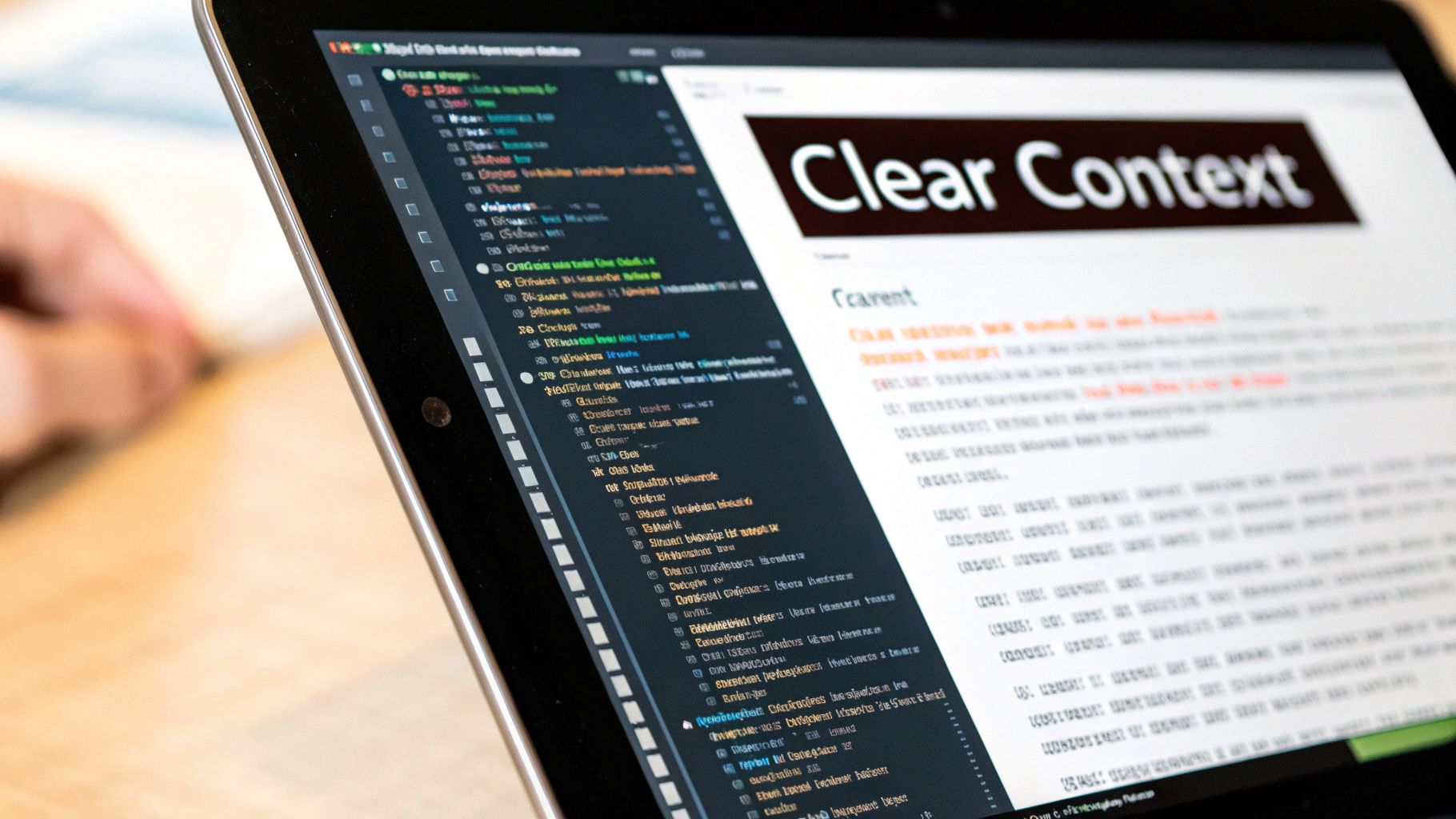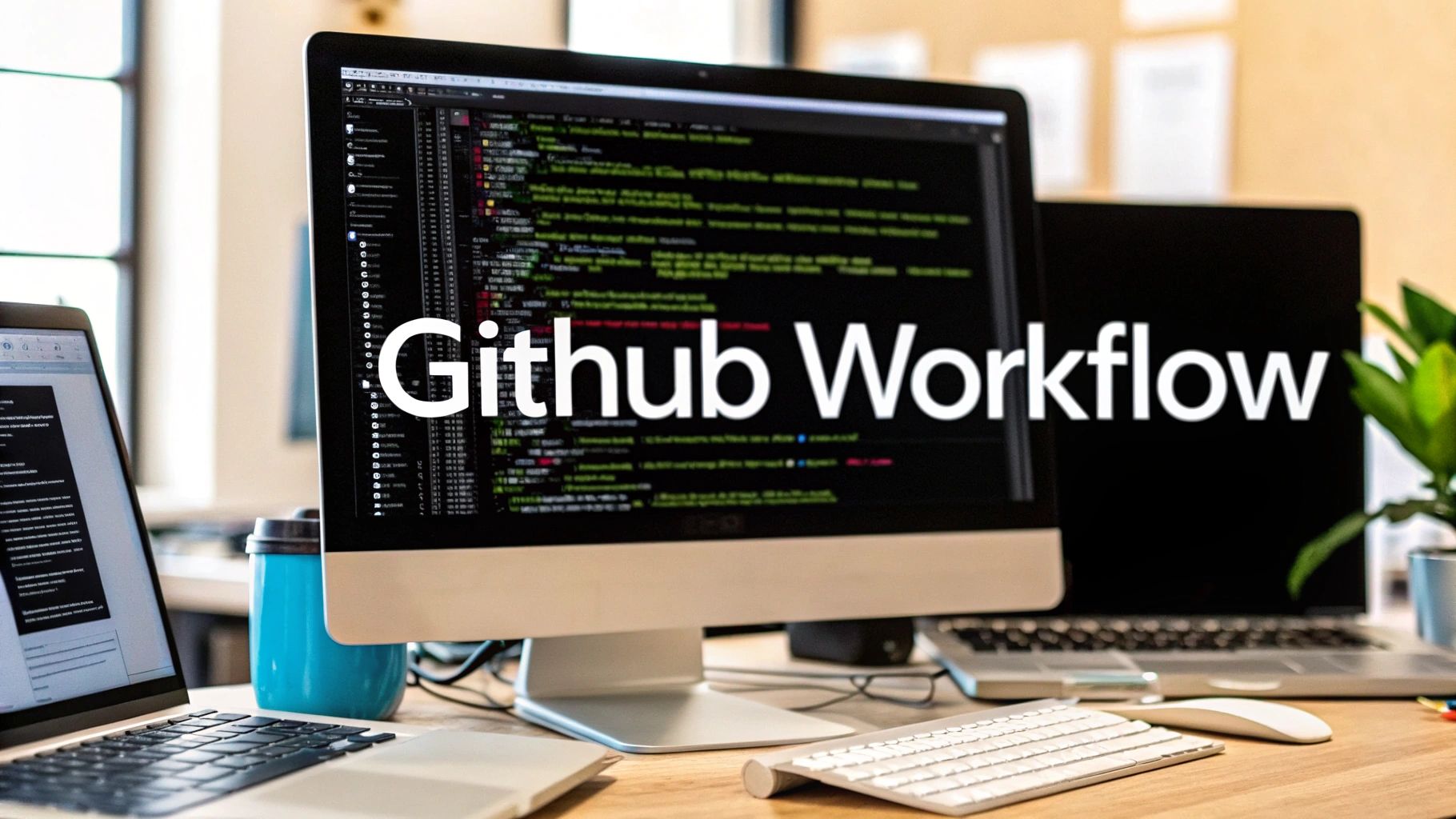7 GitHub PR Template Checklist Essentials
Level Up Your GitHub Workflow
Good code collaboration is at the heart of successful software development. Pull requests (PRs) have fundamentally changed how developers work together, providing a structured way to propose, discuss and merge code changes. But what makes a PR process truly effective? The answer lies in having a clear, well-designed PR template.
In the past, PR descriptions were often scattered and inconsistent, causing confusion, delays and quality issues. A standard PR template creates clarity and structure. It guides developers to include all key information upfront, reduces back-and-forth questions, and helps reviewers understand changes quickly. This saves time, improves code quality, and makes development more enjoyable for everyone involved.
PR templates are valuable across all technical roles - from data scientists managing ML models to system administrators handling infrastructure code, DevOps engineers deploying services, mobile developers building apps, and engineering managers overseeing teams. This article provides 7 essential elements that every GitHub PR template should include to improve your workflow, enhance collaboration, and help your team deliver better code faster. Let's explore how to create PR templates that will take your development process to the next level.
1. Description and Context
A clear description is the foundation of any good Pull Request (PR). The Description and Context section works as a bridge between the PR author and reviewers, explaining exactly what changes were made and why. Getting this part right helps ensure smoother code reviews, better code maintenance, and effective team collaboration.

When you write a good PR description, reviewers can quickly understand what you're trying to accomplish. This speeds up reviews and reduces back-and-forth questions. It also creates a paper trail that helps teams understand code changes months or years later. For example, when debugging a tricky issue, having detailed PR descriptions from past changes can provide crucial context about why certain decisions were made.
Key Elements of an Effective Description:
- Change Summary: A brief overview of what was modified
- Business Context: Why these changes were needed from a business perspective
- Related Issues: Links to relevant tickets (e.g.,
fixes #123orJIRA-456) - Impact Overview: What effects these changes might have on the system
Benefits:
- Makes review process faster and more efficient
- Creates lasting documentation
- Keeps changes focused on project goals
Challenges:
- Takes extra time to write good descriptions
- May need updates if PR changes during review
Best Practices:
- Use Clear Formatting: Add headers, lists and code blocks for readability
- List Key Changes: Make it scannable with bullet points
- Link to Docs: Add references to wikis or external resources
- Stay On Point: Avoid unnecessary details or jargon
This careful approach to PR documentation helps teams across many roles - from developers and engineers to managers and analysts. Clear descriptions make work smoother for everyone involved in the development process.
You might be interested in: [Best Practices for Writing Effective PR Descriptions]. Read also: [How to Use Markdown in GitHub PRs]. By focusing on clear descriptions, you'll help your team work better together.
2. Testing Instructions
Clear testing instructions are essential for successful pull requests. Well-written testing guidance helps reviewers validate code changes quickly and thoroughly, leading to faster reviews and better quality code.

When you provide detailed testing steps, reviewers can easily understand how to check your changes. This prevents back-and-forth questions about testing procedures and helps maintain consistent review standards across the team.
Key elements of good testing instructions:
- Clear step-by-step process: Break down testing into simple, actionable steps
- Environment setup details: List required configurations and dependencies
- Test data needs: Specify what test data is needed and how to get it
- Expected outcomes: Describe what should happen at each step
Benefits:
- Better test coverage: Detailed instructions ensure thorough testing of all key areas
- Faster reviews: Clear steps reduce questions and speed up the review process
- Consistent quality: Standard testing approach improves code quality team-wide
Challenges:
- Missing edge cases: Instructions may not cover every possible scenario
- Complex changes: Large changes can require extensive testing steps
Example test steps for a new Dark Mode feature:
- Start with latest app version
- Log in as regular user
- Go to Settings menu
- Check for Dark Mode toggle
- Enable Dark Mode
- Verify theme changes
- Test various screens and menus
- Turn off Dark Mode and confirm default theme returns
Tips for writing test instructions:
- Include error scenarios: Test both successful and error paths
- List all requirements: Note any needed settings or configurations
- Specify prerequisites: Detail required tools and access
Good testing instructions make reviews smoother and more effective. They help everyone involved - from developers and data scientists to product managers and QA teams - understand how to properly validate changes. Taking time to write clear test steps pays off with higher quality code and faster development cycles.
3. Code Review Checklist
Code reviews are crucial for shipping good software, preventing issues, and building strong engineering teams. Creating a clear Code Review Checklist helps teams systematically check all key elements before approving a pull request.
A good Code Review Checklist includes these key areas:
- Code Style Standards: Verify the code matches your team's guidelines for formatting, naming rules, and language practices. Clean, consistent code makes the codebase easier to read and maintain.
- Speed and Performance: Look for any slowdowns or bottlenecks. Review whether code could be optimized, especially when working with large datasets or complex systems.
- Security Concerns: Check for vulnerabilities like SQL injection risks, cross-site scripting issues, and proper handling of sensitive data. All engineers should verify basic security practices.
- Clear Documentation: Confirm code has helpful comments explaining complex logic and is well-documented. Good documentation helps new team members get up to speed quickly.
Benefits:
- Better Code Quality: Following a checklist ensures consistent standards across your codebase
- Fewer Bugs: Reviews catch potential problems before they hit production
- Team Learning: Junior engineers learn best practices through structured reviews
Making It Work:
- Match Your Team's Needs: Adapt the checklist to your specific project requirements and standards. For example, mobile apps need extra UI/UX review items.
- Stay Current: Update your checklist regularly as security and performance best practices evolve. Check out [Best Practices for Code Reviews].
- Add Language-Specific Items: Include checks for common issues in the programming languages your team uses.
How Code Reviews Have Evolved:
Major tech companies like Google and Microsoft have shaped modern code review practices. Their internal guidelines emphasize clear checklists and structured processes that teams can learn from.
For more insights, see [Effective Code Review Strategies]. Good code reviews lead to higher quality software with fewer bugs and security issues. For helpful resources on optimizing your review process, check out PullChecklist's sitemap. DevOps teams can use this to improve their development workflows.
4. Breaking Changes Alert
A key part of any Pull Request (PR) template is the section for highlighting breaking changes. The "Breaking Changes Alert" communicates modifications that could disrupt existing functionality or require code migrations. Having this warning system helps prevent deployment issues and gives teams time to adapt.

This section emerged from hard lessons learned when code changes broke production features due to poor communication. Now it's a standard best practice that helps teams catch potential issues early.
Key Features:
- API Changes: Document modifications to endpoints, request/response formats, and authentication methods so teams can update integrations
- Migration Steps: Outline required database changes, code updates and configuration updates for proper upgrades
- Version Impact: Specify which software/API versions are affected to help assess scope
- Rollback Instructions: Provide clear steps to revert changes if issues occur after deployment
Real Example:
Consider an API endpoint requiring new authentication. Without proper alerts, dependent teams could face sudden failures. A clear breaking changes notice lets them implement the new auth method on schedule.
Template Example: ⚠️ Breaking: API endpoint /v1/users now requires authentication
This change requires Authorization header with Bearer token for /v1/users endpoint.
Timeline:
- 2024-01-15: Authentication becomes mandatory
Affected:
- /v1/users endpoint
- Client applications using this endpoint
Rollback:
Revert commit [hash] to restore previous behavior
Implementation Tips:
- Use warning symbols (⚠️) to highlight breaking changes
- Include clear timelines for when changes take effect
- List all affected components and systems
- Document rollback steps for emergencies
Why It Matters:
This alert system is crucial for reliable software development. It helps prevent surprises, enables planned migrations, and keeps everyone aligned. From developers to end-users, having clear breaking change notices makes updates smoother and systems more stable. The small effort of documenting changes upfront prevents much larger issues later.
5. Dependencies and Requirements
Your pull requests (PRs) need to clearly outline any project dependencies and requirements. Proper documentation makes the review process smoother, prevents unexpected deployment issues, and helps teams understand the impact of changes. This is especially critical for teams using CI/CD practices.
Good dependency documentation creates a clear record that helps with troubleshooting, security audits, and maintaining stability. Clear communication around dependencies encourages collaboration between developers, ops teams, and security reviewers.
Key Areas to Document:
- Package versions that are added, upgraded, or downgraded
- Environment needs like OS versions, runtimes (Python 3.9, Java 17), and database versions
- Infrastructure modifications including server changes or cloud resource updates
- Third-party service dependencies like APIs or authentication providers
Benefits:
- Catches potential deployment conflicts early
- Enables better resource and budget planning
- Makes security reviews more thorough and efficient
Challenges:
- May need extra approvals from security/infrastructure teams
- Documentation requirements can extend PR timelines
Best Practices:
- Always explain why dependencies are being updated - for example: "Updating to requests 2.28.1 to fix CVE-2022-1234"
- Use specific version requirements like "numpy>=1.20.0" rather than just "numpy"
- Link to official docs for each dependency to help reviewers
Real Example:
Consider a data science PR that:
- Updates scikit-learn from 0.24 to 1.0 for better performance
- Adds TensorFlow 2.7 to enable GPU acceleration
- Requires Python 3.8+ for compatibility
By listing these changes clearly, teams can prepare the right environment before deployment.
Teams find that documenting dependencies early in development helps them move faster and deliver more reliably. Understanding what a PR needs helps prevent problems before they impact production.
For a broader look at PR best practices, check out the other sections of this checklist.
Read also: [Understanding Semantic Versioning for Dependency Management]
Good dependency management directly affects your project's stability, security and maintainability. Taking time to document requirements thoroughly helps create more robust software and smoother deployments.
6. Performance Impact
A small code change can have a major effect on how your system runs. Changes that seem minor could slow down your application or even cause system outages. That's why it's essential to carefully assess the performance impact of every pull request. This helps ensure your code changes won't degrade the user experience.
With teams shipping code more frequently through CI/CD pipelines, automated performance testing has become a must-have practice. Regular testing helps catch issues before they reach production.
Key elements to include in performance assessments:
- Core Metrics: Measure key indicators like latency, throughput, error rates and response times
- Load Testing: For critical components, run tests that mimic real user traffic patterns
- Resource Usage: Track changes in CPU, memory, disk and network utilization
- Scale Impact: Evaluate how changes affect system scalability
Benefits of performance testing in PRs:
- Prevents Issues: Catch performance problems before they impact users
- Improves Planning: Better understand future infrastructure needs
- Records Decisions: Document why optimization choices were made
- Builds Culture: Makes performance a priority across the team
Sample performance statements:
- "Query time reduced from 500ms to 100ms using benchmark X with dataset Y"
- "Memory usage dropped 25% during 1000-user load test"
- "New caching layer cut database reads by 90%"
Best practices for performance testing:
- Show Comparisons: Include clear before/after metrics
- Detail Test Setup: Document test environment and conditions
- Explain Changes: Note why optimizations were chosen
- Automate Tests: Add performance checks to CI pipeline using tools like JMeter, Gatling, and k6
Carefully checking performance helps build faster, more reliable systems. This practice matters for many roles - from engineers and DevOps teams to product managers and IT teachers. Regular performance testing helps catch issues early while building a culture focused on delivering great user experiences.
7. Deployment Strategy
A well-planned deployment strategy helps teams launch code safely into production and avoid common issues. Having a dedicated "Deployment Strategy" section in your GitHub Pull Request template ensures everyone understands the rollout plan.

As software systems grow more complex with microservices and cloud infrastructure, careful deployment planning has become essential. A clear strategy helps coordinate among developers, operations teams, and other stakeholders.
Key Elements of a Good Deployment Strategy Section:
- Step-by-Step Process: Outline specific deployment steps like "Deploy to staging > Run tests > Deploy canary > Roll out to production servers"
- Feature Flag Plan: Note which feature flags need enabling/disabling and when (e.g. "Enable
new-searchflag after staging deploy") - Rollback Steps: Include exact commands and procedures for reverting changes if needed
- Monitoring Plan: List key metrics to watch and acceptable thresholds (e.g. "Monitor error rate, alert if >2%")
Benefits of Including the Strategy:
- Lower Risk: Having clear steps and rollback plans reduces chance of issues
- Better Monitoring: Explicit monitoring guidance helps catch problems early
- Quick Recovery: Well-defined rollback steps enable fast incident response
- Team Alignment: Everyone knows the plan and their role
Common Deployment Approaches:
- Progressive Rollout: "Start with 10% of users, monitor for 24 hours, expand to 50%, then 100% after 48 hours if stable"
- Blue-Green: "Deploy new version to 'green' environment, verify, then switch traffic from 'blue' to 'green'"
- Canary Testing: "Deploy to small user group first, expand gradually if no issues found"
Tips for Success:
- Plan Gradual Releases: Roll out changes in phases to limit potential impact
- Define Key Metrics: List specific metrics and thresholds to monitor
- Document Testing: Note how each deployment stage will be validated
- Use Checklists: Break complex deployments into clear, verifiable steps
Adding a deployment strategy section to your PR template helps create consistent, reliable releases. By carefully planning deployments and documenting the process, teams can ship changes more confidently while maintaining system stability.
GitHub PR Template: 7-Point Comparison
| Checklist Item | 🔄 Implementation Complexity | ⚡ Resource Requirements | 📊 Expected Outcomes | 💡 Ideal Use Cases | ⭐ Key Advantages | |-----------------------------|------------------------------------------------------------------|---------------------------------------------------------------|-------------------------------------------------------------------------|--------------------------------------------------------------------------|----------------------------------------------------------| | Description and Context | Moderate – requires detailed narrative creation | Needs documentation resources and links to external issues | Clear rationale with documented change impact | When clear context and change summaries are critical | Quick reviewer understanding and solid documentation trail| | Testing Instructions | Moderate – involves step-by-step instruction drafting | Requires test data setup and configuration details | Standardized testing process that reduces iterative clarifications | For functional verifications and complex change scenarios | Ensures thorough testing with reduced communication gaps | | Code Review Checklist | Low – standardized list with predefined criteria | Minimal – mainly a checklist review | Consistent code quality and adherence to best practices | Routine code reviews and ensuring compliance with coding standards | Prevents common mistakes and facilitates knowledge sharing | | Breaking Changes Alert | Low to Moderate – focus on highlighting critical risks | Minimal – uses warnings and formatted alerts | Proactive communication to avoid unforeseen breaking issues | When changes may disrupt backward compatibility or system stability | Mitigates production risks and aids stakeholder planning | | Dependencies and Requirements| Moderate – involves listing and verifying changes | May need cross-team coordination and external approval processes | Mitigates deployment issues by detailing dependency and system updates | PRs introducing new dependencies or altering system requirements | Enhances resource planning and security review | | Performance Impact | High – requires analysis, benchmarking, and load testing | Demands performance testing tools and data measurement setups | Quantifiable improvements in system speed and resource optimization | For performance-critical changes and optimization efforts | Prevents regressions and aids in capacity planning | | Deployment Strategy | Moderate – involves planning rollout steps and rollback procedures | Needs monitoring systems and staged rollout resources | Smooth, risk-managed deployment with clear monitoring and fallback options| When a staged or complex deployment process is necessary | Reduces deployment risks and improves incident response |
Ready to Streamline Your Reviews?
A well-crafted GitHub PR template checklist makes code reviews more efficient and valuable. The key elements include clear descriptions, testing guidance, specific review points, change alerts, dependency details, performance notes, and deployment plans. When teams consistently use these elements, they write better code, catch issues early, and ship features faster. The most effective checklists evolve based on team feedback and lessons learned from past pull requests.
The tools and practices for code review keep improving, including AI-powered analysis and automated checks. Teams that stay current with proven approaches while selectively adopting helpful new capabilities tend to have the smoothest review processes.
Key Takeaways:
- Focus on Clarity: Write PR descriptions that give clear context
- Enable Testing: Document test steps for thorough validation
- Structure Reviews: Use checklists to guide consistent feedback
- Flag Changes: Call out breaking changes and performance impacts
- List Dependencies: Specify all requirements for integration
- Define Deployments: Document release and rollout plans
- Keep Improving: Update checklists based on team input and results
Want to upgrade your code review process? Skip the hassle of manual checklists and inconsistent practices. Pull Checklist, available on the GitHub Marketplace, brings automated, condition-based checklists to your pull requests. Set required checks, block merges on failed items, and track completion—right where you review code. The tool helps teams deliver high-quality reviews consistently, even on unfamiliar code. With customizable templates and reporting, Pull Checklist enables clear visibility and smooth collaboration. Visit Pull Checklist to see how it can help your team.
